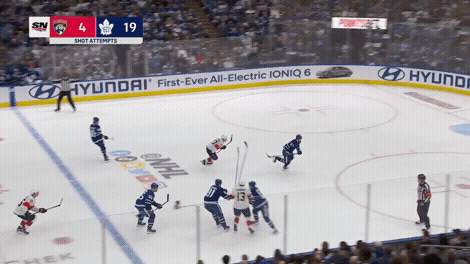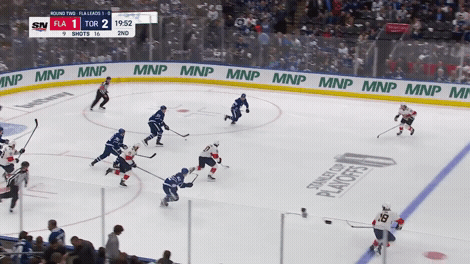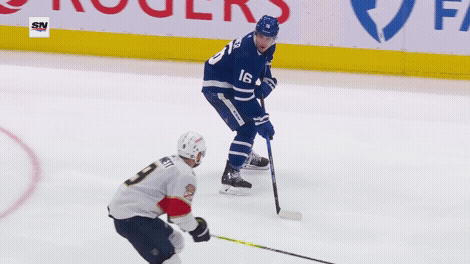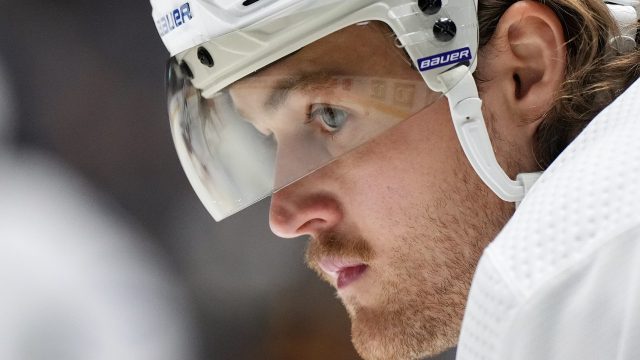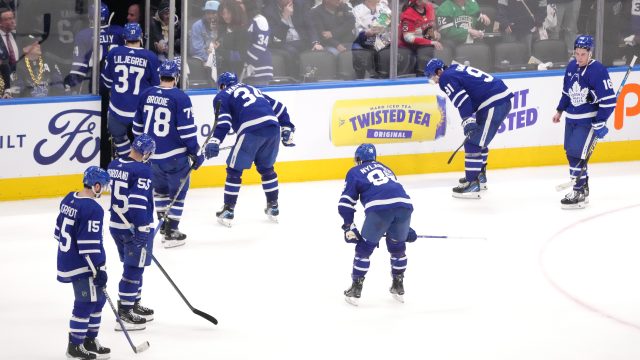
There aren’t many Toronto Maple Leafs fans who still think it matters when the team “deserved” a better outcome. The Leafs deserved to win Game 2, and roughly nobody cares.
The idea that the Leafs have had a “good process” has held water over years of disappointing playoff results, it held the core intact to take yet another post-season shot together, and hey, it had a good run. But few fans care anymore. Not even after the Leafs had 25 slot shots to the Panthers 14 in Game 2, or that the Leafs controlled o-zone possession time (7:24 to 3:55), led in expected goals (3.5 to 2.7), and owned several varieties of “deserve-to-win-o-meters.”
There was some irony in the way the Maple Leafs finally found their way over the hump in the first round, as the team that probably didn’t “deserve” to win the series by the numbers, but did the things necessary to “get lucky.”
Funny how, when they got the luck in that first round, many observers ascribed the success they had as earning that luck, right? They hung around without making any glaring errors, they got traffic to the net front and, to some extent, they played in a way that allowed them to take advantage of whatever good breaks they did get.
If creating luck – or at least staying patient in a game long enough to get good luck – is in itself not entirely luck, then it’s tough to call the Leafs unlucky?
A few thoughts on Game 2 and where the Leafs are at.
Florida’s rope-a-dope and quick-strike
After Game 1 I wrote about how the Panthers found success against Boston, leading the NHL by a good deal in goals scored within five seconds of a turnover. They did it seven times in the first round, and while none of their goals in Game 1 against Toronto quite met that criteria, the Carter Verhaeghe game winner came off a Leafs rush turnover and ended up being the difference.
In Game 2 they scored two more within five seconds of a turnover, bringing their post-season total to nine, where the next best total is Seattle’s five (the Leafs have two of these such goals).
As the clear underdog, Florida has been content to play the Leafs bend-but-don’t-break style from round one, be patient, and wait for their chances. When the Leafs came out a little too casual in the second period after an outright dominant first – it felt like it was going to be easy, I’m sure – the Panthers made them pay. Then Florida held on for dear life and got save after save from Sergei Bobrovsky, who’s a flawed but talented goalie capable of getting hot for stretches of play.
Which brings me to my biggest talking point of the day…
Toronto’s lack of second chance opportunities
Toronto had 25 slot shots in Game 2, which is a pile. They’ve generated more shots and inner slot looks and high danger attempts and all that, which is great. But just two of their shots in Game 2 were classified by Sportlogiq as rebound chances. One of them was originally fired by the shockingly effective Luke Schenn (who I’ll note had three shots and five attempts), and was picked up by Alex Kerfoot for a goal.
Bobrovsky sells out on saves (which can leave goalies vulnerable to follow-up opportunities), and so the key is forcing him to make two in a row, which the Leafs haven’t yet done with any consistency. Solving Florida’s defence is no longer the conversation — they’re doing that — it’s solving Goalie Bob.
Florida’s D are suspect, but on each pair is some variety of a butcher, whether it’s Radko Gudas or Marc Staal or Aaron Ekblad, each of whom makes it relatively unpleasant to camp out net front. So the Leafs have seen a small decline in the number of screened shots they’re landing on net, and a noticeable decline in the amount of follow-up opportunities.
This is a “vibes” thing, but I think going up against Tampa Bay had them prepared for a war – the Lightning are notoriously physical and verbal and competitive. The Leafs were going to have to be, too. Well, Florida failed in the playoffs last season, believing that they lacked those elements, so they made changes to get nastier. They brought in Matthew Tkachuk for Jonathan Huberdeau and MacKenzie Weegar, and they make things less comfortable now. The Leafs need to have the same respect for Florida’s physical game as Tampa’s, dig in, and prepare for those miserable net-front battles.
By and large the Leafs have been unlucky that nothing has bounced to their sticks, and the other goalie is certainly playing great, but they can make it harder for Bobrovsky by creating more action on top of him.
Nylander, Matthews, and Marner
After Game 1 I questioned Nylander in a few ways, namely his effort without the puck. I thought he was the best player on the rink in Game 2 by a good margin, constantly making the Panthers miss and creating rush opportunities. Toronto generated eight odd man rushes to Florida’s two, leading to eight attempts from the slot, many of which were set up by the Leafs’ smooth winger.
I’ve seen him critiqued for the turnover that led to the Panthers’ third goal, and look, it wasn’t great. But hanging on to the puck is also what led to a lot of the Leafs’ offence-creation, and Nylander is not a turnover risk in general. By turnover rate percentage (compared to their touches), the three forwards who turn it over least often on the Leafs are Matthews, then Ryan O’Reilly, then Nylander. Among the players asked to produce offence, Bunting, Tavares, and Marner are more likely to turn it over.
Here’s a sample of Nylander’s controlled entries from just the third period last night:
These three players combined for 18 shots on goal in Game 2, and had great moments where it just wouldn’t go in. Matthews was dynamic and once again the team’s best threat to score, with the Leafs carrying over 83 per cent of the expected goals when he was on the ice (not surprisingly, he leads the team in rebounds recovered in the O-zone).
Now, Marner has escaped a lot of criticism through eight games, likely on the backs of the six points he tallied in Toronto’s 7-3, 7-2 opening games against Tampa Bay (and Andrei Vasilevskiy wasn’t his best self on Marner’s two goals in the rout). He hasn’t been great. But in Game 2, he came out with a passion and was dangerous on every touch he had in the first period. The way Toronto is constructed, they’ll need way more of that from him in the next couple games.
On the goals against:
1st: Tavares blows a wheel, but Timothy Liljegren can’t be reversing this behind his own net. A reverse is supposed to be when a D-man cuts behind his net and sends it back towards the corner. All the worst-case scenarios played out after that.
2nd: You don’t love the Nylander turnover, but Jake McCabe gets jammed up and forces the puck to 88 when he had smoother options in the middle, and Ilya Samsonov needs to make that save.
3rd: Matthews gets the documented turnover, but Marner doesn’t seem to be moving his feet in the playoffs like he can. No reason he can’t skate the puck forward rather than putting his linemate in a bad spot. (They also get passed around a few times after the gaffe.)
At the end of the day, the Leafs came out to start the second period like it was going to be easy after a first where they controlled the run of play. It’s rarely, if ever, easy in the playoffs.
Rapid Fire
• Justin Holl kills the opposing cycle well, and Liljegren has held up poorly in the face of Florida’s pressure. They have to make that switch, or go 11-7 and bring in Holl to replace Knies, who’s out with a concussion.
• Another option is to bring in Holl and Erik Gustafsson, and pulling out Liljegren. Mark Giordano has struggled so completely that having someone else to make a dynamic play from the back end might help, and he can’t hurt them much more defensively. (That said, up a goal, I still want Giordano out there over Gustafsson, so personal preference is 11-7 with Holl and Liljegren in.)
• Speaking of Knies, he’s been remarkably effective for them at creating offence, being on the ice for game tying goals at 6-on-5 and all their OT winners. They missed him in Game 2. He’s getting smoked a lot because they don’t hit as much in college, but in the NHL they don’t hit this much until rounds one and two of the playoffs. I’m sure it’s been an adjustment. The Bennett play was greasy.
Conclusion
The Leafs are not out of this series.
According to the website MoneyPuck, Bobrovsky has been the best goalie left in the playoffs, stopping nearly six goals above what would be expected from a league average goalie. He’s also 34 and had a .901 save percentage this season, so … that could regress (and will if the Leafs do what’s discussed above and crash the crease more).
They need better finishing, more awareness of the potential for quick strikes against, and an acceptance that Florida is good, and this is going to be a grind. It’s too soon for Leafs fans to hop off the bandwagon — the team is too good and there’s too much hockey to be played.
But if they don’t get a handle on these few issues, a first-round victory isn’t going to matter much in the face of second round disappointment.


